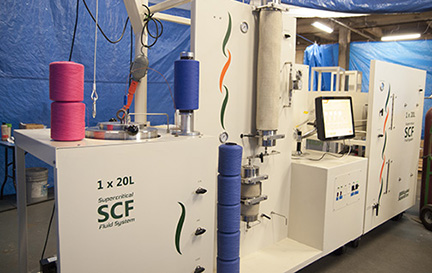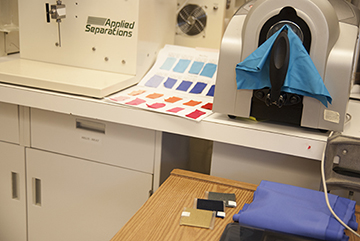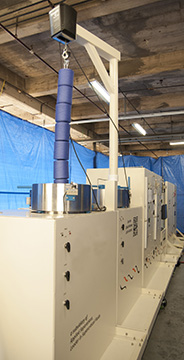The conventional dyeing of textiles requires that an excess of dye is dissolved or in some way "taken-up" in an aqueous or solvent solution. The dye mix is then pumped into a vat containing holding the textile. Typically there is agitation or the dye is recirculated several times through the cloth. At the end of the cycle, the dye mix is pumped to the waste treatment facility. Dyes are notoriously difficult to treat. The process is decidedly unfriendly to the environment.
The use of supercritical CO2 in textile dyeing is an environmentally friendly, sustainable alternative. Instead of using an aqueous or solvent solution to "take-up" the dye, supercritical CO2 is used. The process proceeds in the same manner as the conventional method, but instead of sending the spent mix to the waste treatment facility, the supercritical CO2 /dye mix is depressurized. The CO2 changes to a gas and all the spent dye falls out and can be reused. In production systems, the CO2 is recycled for providing for a completely closed system and an entirely environmentally friendly approach to textile dyeing.
Our Process for dyeing polyester offers the following advantages versus conventional dyeing in water
• CO2 replaces water as the dye solvent
• Saves energy
• Uses fewer chemicals
• Generates practically no waste streams
• Carbon dioxide is recycled and not vented
• Reduces the number of process steps
• Simplifies dyeing chemistry
• Reduces plant footprint
• Flexibility in site location
Additional technology to support your dyeing operations:
• 60 - 90-minute dyeing cycle depending on the color
• Selection of disperse dyes that work well in our process. Create a palette of colors with these dyes.
• Color database for your use
• Use color match capability
• Dyed polyester meets AATCC tests
The operation, as shown above, follows in this manner:
- Supercritical CO2 flows into the dye make-up vessel where it dissolves the dye.
- It continues to the dye vessel which contains the textile cocoon.
- Dyeing can continue in a static bath or a specially designed pump recirculates the mix several times through the cocoon.
- At the end of the cycle, the mix flows to the dye collection vessel where depressurization occurs causing the spent dye to drop out.
- The CO2 can then be recycled and the "spent" dye reused.


